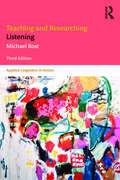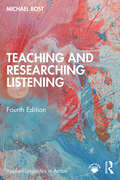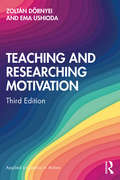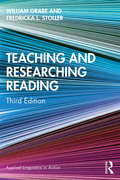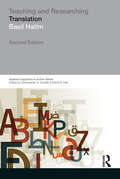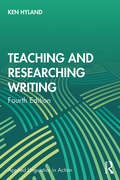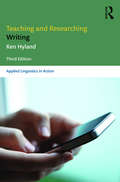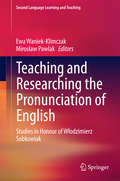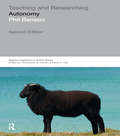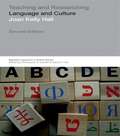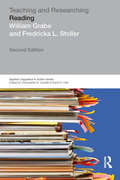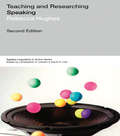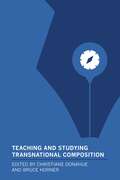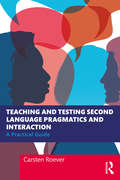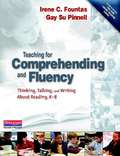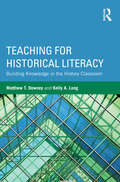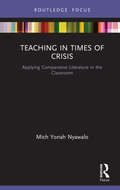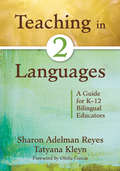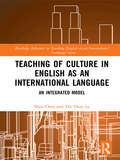- Table View
- List View
Teaching and Researching Listening: Third Edition (Applied Linguistics in Action)
by Michael RostNow in its third edition, Teaching and Researching Listening renews its commitment to provide language educators, practitioners, and researchers in the fields of ESL, TESOL, and Applied Linguistics with a state-of-the-art treatment of the linguistic, psycholinguistic and pragmatic processes underpinning oral language use, and demonstrates how they influence listening in a variety of practical contexts. This revised edition incorporates significantly updated sections on neurological processing, pragmatic processing, automated processing, and pragmatic assessment, as well as coverage of emerging areas of interest in L1 and L2 instruction and research. Boxes throughout, including "Concepts" and "Ideas From Practitioners", help to both reinforce readers’ understanding of the topics covered and ground them in a practical context, while the updated chapter, "Exploring listening", contains an overhauled section on listening technologies that provide readers with a range of tools to explore other perspectives on listening. Combining detailed overviews of the underlying processes of listening with an exhaustive set of practical resources, this third edition of Teaching and Researching Listening serves as an authoritative comprehensive survey of issues related to teaching and researching oral communication for language teachers, practitioners, and researchers.
Teaching and Researching Listening: Third Edition (Applied Linguistics in Action)
by Michael RostWidely considered to be a foundational work in the field of listening, Teaching and Researching Listening is among the most recommended textbooks in applied linguistics oral communication courses, and the most cited reference in current research on second language listening development. Known for its comprehensiveness, clarity, insight, and practical applications, this fourth edition has been substantially revised to reflect the latest research in the areas of linguistics, neuroscience, applied technologies, and teaching methodology, with expanded sections on teaching applications and explorations in social research related to listening.This completely revised edition includes:• Detailed overviews of the underlying processes of listening, with additional coverage of decoding processes• Expansion of sections dealing with artificial intelligence (AI), speech recognition, and input enhancement software• Emphasis on research of listening in spoken interaction and cross-cultural communication • Clear templates for instructors and curriculum designers, with an expansive set of practical resources• Guidance in using observational methods for exploring listening in a range of educational and professional contexts• Website support, with presentation slides, infographics, and question banks for each chapterThis fourth edition of Teaching and Researching Listening serves as an authoritative and comprehensive survey of issues related to teaching and researching oral communication, providing value for language teachers, educational researchers, instructional designers, interpreters, and other language practitioners.
Teaching and Researching Motivation (Applied Linguistics in Action)
by Zoltán Dörnyei Ema UshiodaCultivating motivation is crucial to a language learner's success – and therefore crucial for the language teacher and researcher to understand. The third edition of Teaching and Researching Motivation reflects the dramatic changes in the field of motivation research. With an increased emphasis on dynamic perspectives on motivation and its relations with other individual, social and contextual factors, this book offers ways in which advances in the field can be put to practical use in the classroom and in research. Key new features and material: exploration of the motivation to learn languages other than English (LOTEs); principles for designing L2 motivational studies; discussion of emerging areas of research, including unconscious motivation and language learning mindsets. Providing a clear and comprehensive theory-driven account of motivation, Teaching and Researching Motivation examines how theoretical insights can be used in everyday teaching practice. The final section provides a range of useful resources, including relevant websites, key reference works and an online repository of tools and instruments for researching language learning motivation. Fully revised by pre-eminent researchers in this field, Zoltán Dörnyei and Ema Ushioda, this is an invaluable resource for teachers and researchers alike.
Teaching and Researching Reading: Third Edition (Applied Linguistics in Action)
by William Grabe Fredricka L. StollerNow in its third edition, Teaching and Researching Reading charts the field of reading (first and second language) systematically and coherently for the benefit of language teaching practitioners, students, and researchers. This volume provides background on how reading works and how reading differs for second language learners. The volume includes reading-curriculum principles, evidence-based teaching ideas, and a multi-step iterative process for conducting meaningful action research on reading-related topics. The volume outlines 14 projects for teacher adaptation and use, as well as numerous new and substantially expanded resource materials that can be used for both action research and classroom instruction.
Teaching and Researching Speaking: Third Edition (Applied Linguistics in Action)
by Beatrice Szczepek Reed Rebecca HughesTeaching and Researching Speaking provides an overview of the main approaches to researching spoken language and their practical application to teaching, classroom materials, and assessment. The history and current practices of teaching and researching speaking are presented through the lens of bigger theoretical issues about the object of study in linguistics, social attitudes to the spoken form, and the relationships between spoken and written language. A unique feature of the book is the way it clearly explains the nature of speaking and how it is researched and puts it into the context of a readable and holistic overview of language theory. This new edition is fully updated and revised to reflect the latest developments on classroom materials and oral assessment, as well as innovations in conversation analysis. The resources section is brought up-to-date with new media and currently available networks, online corpora, and mobile applications. This is a key resource for applied linguistics students, English language teachers, teacher trainers, and novice researchers.
Teaching and Researching Translation (Applied Linguistics in Action)
by Basil A. HatimTeaching & Researching Translation provides an authoritative and critical account of the main ideas and concepts, competing issues, and solved and unsolved questions involved in Translation Studies. This book provides an up-to-date, accessible account of the field, focusing on the main challenges encountered by translation practitioners and researchers. Basil Hatim also provides readers and users with the tools they need to carry out their own practice-related research in this burgeoning new field. This second edition has been fully revised and updated through-out to include: The most up-to-date research in a number of key areas A new introduction, as well as a new chapter on the translation of style which sets out a new agenda for research in this field Updated examples and new concepts Expanded references, bibliography and further reading sections, as well as new links and resources Armed with this expert guidance, students of translation, researchers and practitioners, or anyone with a general interest in this fast-developing field can explore for themselves a range of exemplary practical applications of research into key issues and questions. Basil Hatim is Professor of Translation & Linguistics at the American University of Sharjah, UAE and theorist and practitioner in English/Arabic translation. He has worked and lectured widely at universities throughout the world, and has published extensively on Applied Linguistics, Text Linguistics, Translation/Interpreting and TESOL.
Teaching and Researching Writing (Applied Linguistics in Action)
by Ken HylandThe new edition of Ken Hyland’s text provides an authoritative guide to writing theory, research, and teaching. Emphasising the dynamic relationship between scholarship and pedagogy, it shows how research feeds into teaching practice. Teaching and Researching Writing introduces readers to key conceptual issues in the field today and reinforces their understanding with detailed cases, then offers tools for further investigating areas of interest. This is the essential resource for students of applied linguistics and language education to acquire and operationalise writing research theories, methods, findings, and practices––as well as for scholars and practitioners looking to learn more about writing and literacy. New to the fourth edition: Added or expanded coverage of important topics such as translingualism, digital literacies and technologies, multimodal and social media writing, action research, teacher reflection, curriculum design, teaching young learners, and discipline-specific and profession-specific writing. Updated throughout––including revision to case studies and classroom practices––and discussion of Rhetorical Genre Studies, intercultural rhetoric, and expertise. Reorganised References and Resources section for ease of use for students, researchers, and teachers.
Teaching and Researching Writing: Third Edition (Applied Linguistics in Action)
by Ken HylandThis third edition of Teaching and Researching Writing continues to build upon the previous editions' work of providing educators and practitioners in applied linguistics with a clearly written and complete guide to writing research and teaching. The text explores both theoretical and conceptual questions, grapples with key issues in the field today, and demonstrates the dynamic relationship between research and teaching methods and practice. This revised third edition has been reorganized to incorporate new topics, including discussions of technology, identity, and error correction, as well as new chapters to address the innovative directions the field has taken since the previous edition's publication. Boxes throughout, including "Concepts" and "Quotes", help to both reinforce readers' understanding of the topics covered by highlighting key ideas and figures in the field, while the updated glossary and resource sections allow readers to further investigate areas of interest. This updated edition of Teaching and Researching Writing is the ideal resource for language teachers, practitioners, and researchers to better understand and apply writing research theories, methods, and practices.
Teaching and Researching the Pronunciation of English
by Mirosław Pawlak Ewa Waniek-KlimczakThe book contains contributions from practitioners and theoreticians who explore the pronunciation of English from various perspectives: phonetic, phonological, psycholinguistic and sociolinguistic. In accordance with the unifying theme of the volume, individual contributions investigate the characteristics of a foreign accent, its production and perception, study the development of methods and techniques in pronunciation teaching, evaluate their use in classroom materials and in the classroom itself, and investigate the conditions for second language learning and teaching from the perspective of learners and teachers. The book offers a unique combination of a scholarly research with practical applications, inspired over the years by the work of Professor Włodzimierz Sobkowiak, who has researched pronunciation teaching and pioneered technology-oriented, corpus-based approaches to the study of English pronunciation in Poland.
Teaching and Researching: Autonomy in Language Learning (Applied Linguistics in Action)
by Phil BensonAutonomy has become a keyword of language policy in education systems around the world, as the importance of independent learning and new technologies has grown. Now in a fully revised and updated second edition, Teaching and Researching Autonomy provides an accessible and comprehensive critical account of the theory and practice of autonomy. Examining the history of the concept, it addresses important questions of how we can identify autonomy in language learning behaviours and how we can evaluate the wide variety of educational practices that have been designed to foster autonomy in learning. Topics new to this edition include: - Autonomy and new technologies - Teacher autonomy - The sociocultural implications of autonomy With over three hundred new references and five new case studies of research on autonomy providing practical advice on research methods and topics in the field, Teaching and Researching Autonomy will be an essential introduction for teachers and students to a subject at the cutting edge of language teaching and research.
Teaching and Researching: Language and Culture (Applied Linguistics in Action)
by Joan Kelly HallLanguage and culture are concepts increasingly found at the heart of developments in applied linguistics and related fields. Taken together, they can provide interesting and useful insights into the nature of language acquisition and expression. In this volume, Joan Kelly Hall gives a perspective on the nature of language and culture looking at how the use of language in real-world situations helps us understand how language is used to construct our social and cultural worlds.The conceptual maps on the nature of language, culture and learning provided in this text help orient readers to some current theoretical and practical activities taking place in applied linguistics. They also help them begin to chart their own explorations in the teaching and researching of language and culture.
Teaching and Researching: Motivation (Applied Linguistics in Action)
by Zoltán Dörnyei Ema UshiodaCultivating motivation is crucial to a language learner's success - and therefore crucial for the language teacher and researcher to understand. This fully revised edition of a groundbreaking work reflects the dramatic changes the field of motivation research has undergone in recent years, including the impact of language globalisation and various dynamic and relational research methodologies, and offers ways in which this research can be put to practical use in the classroom and in research. Key new features and material:· A brand new chapter on current socio-dynamic and complex systems perspectives · New approaches to motivating students based on the L2 Motivational Self System· Illustrative summaries of qualitative and mixed methods studies· Samples of new self-related motivation measures Providing a clear and comprehensive theory-driven account of motivation, Teaching and Researching Motivation examines how theoretical insights can be used in everyday teaching practice, and offers practical tips. The final section provides a range of useful resources, including relevant websites, key reference works and tried and tested example questionnaires. Written in an accessible style and illustrated with concrete examples, it is an invaluable resource for teachers and researchers alike.
Teaching and Researching: Reading
by William Peter Grabe Fredricka L. StollerTeaching and Researching Reading was first written to help language professionals understand the complex nature of reading. Now in a thoroughly updated and improved second edition, the book expands connections from research on reading to instructional practices and teacher-initiated action research. Offering an updated overview of reading theory, it summarises key ideas and issues in first and second language contexts. In addition to providing insightful research analyses, Grabe and Stoller offer practical advice for practitioners and researchers, including evidence-based teaching ideas and a multi-step iterative process for conducting meaningful action research on reading-related topics. The volume outlines 29 projects for teacher adaptation and use, as well as numerous new or substantially expanded resource materials that can be used for both action research and classroom instruction. Learning aids featured throughout the volume include · key concept boxes and a glossary of key terms · quote boxes highlighting critical issues in the field · resource lists of relevant journals, books and websites Fully revised throughout, with a range of new exemplary L1 and L2 research studies and an entirely new chapter on the move from research implications to instructional applications, this second edition of Teaching and Researching Listening is an invaluable resource for teacher trainers, practicing teachers, materials writers and researchers alike.
Teaching and Researching: Speaking
by Rebecca HughesSpeaking is a dynamic, interpersonal process and one that strongly influences how we are perceived by others in a range of formal and everyday contexts. Despite this, speaking is often researched and taught as if it is simply writing delivered in a different mode. In Teaching and Researching Speaking, Rebecca Hughes suggests that we have less understanding than we might of important meaning-making aspects of speech such as prosody, gaze, affect, and the ways speakers collaborate and negotiate with one another in interaction. This thoroughly revised and updated second edition looks to the future of the field, offering: A new chapter on assessment, discussing 'high stakes' oral language testing contexts such as immigration New material considering access to spoken data via the worldwide web and new technologies that allow neurolinguistic insights formerly hidden from view Summaries and case studies to help the reader understand how to approach researching speaking and encourages practitioners to question the models of speaking that they are using in their classrooms. Reviewing materials and assessment practices in the light of current knowledge about spoken language, and highlighting areas for new work and collaboration between researchers and practitioners, this book will be a valuable resource for anyone involved in language teaching.
Teaching and Studying Transnational Composition
by Christiane Donahue and Bruce HornerTransnational composition is a site for engaging with difference across populations, economies, languages, and borders and for asking how cultures, languages, and national imaginaries interanimate one another.Organized in three parts, the book addresses the transnational in composition in scholarship, teaching, and administration. It brings together contributions from institutional, geopolitical, and cultural contexts ranging across North America, Europe, Latin America, Africa, the Middle East, Asia, and the Caribbean and covers writing in English, Chinese, multiple European languages, Latin American Spanish, African and West Indian Creoles, and Guianan French. Exploring the relationship among transnational, international, global, and translingual approaches to composition--while complicating the term composition itself--essays draw on theories of border work, mobility, liminality, cross-border interaction, center-periphery contours, superdiversity, and transnational rhetoric and address, among other topics, models of cognitive processing, principles of universal design, and frames of critical literacy awareness.
Teaching and Testing L2 Interactional Competence: Bridging Theory and Practice (Routledge Advances in Second Language Studies)
by M. Rafael Salaberry Silvia KunitzThis volume features the latest research findings on L2 interactional competence to demonstrate the potential for developing and implementing research-based pedagogy that targets interactional competence (IC) in early instruction in a variety of L2 learning and teaching contexts. Incorporating contributions from both leading and emerging researchers in the area, the book is organized into four sections to provide a systematic account of interactional competence, defined as a set of skills required to co-construct an effective interaction with a variety of interlocutors in a variety of settings, and advocates for IC to be part of a well-rounded curriculum of L2 instruction. The volume provides a comprehensive overview of the different theoretical perspectives on IC within Conversation Analysis, and moves into a discussion of conversation-analytic research findings from a variety of contexts and of their pedagogical implications.The book then presents examples of pedagogy in practice and also illustrates the potential for implementing IC in testing settings. This volume makes a valuable contribution to the growing literature on interactional competence and will be of particular interest to graduate students and researchers in applied linguistics, SLA, language education, curriculum and instruction studies, and educational linguistics.
Teaching and Testing Second Language Pragmatics and Interaction: A Practical Guide
by Carsten RoeverPragmatic ability is crucial for second language learners to communicate appropriately and effectively; however, pragmatics is underemphasized in language teaching and testing. This book remedies that situation by connecting theory, empirical research, and practical curricular suggestions on pragmatics for learners of different proficiency levels: It surveys the field comprehensively and, with useful tasks and activities, offers rich guidance for teaching and testing L2 pragmatics. Mainly referring to pragmatics of English and with relevant examples from multiple languages, it is an invaluable resource for practicing teachers, graduate students, and researchers in language pedagogy and assessment.
Teaching and Training for Global Engineering: Perspectives on Culture and Professional Communication Practices
by Madelyn Flammia Kirk St. AmantProvides a foundation for understanding a range of linguistic, cultural, and technological factors to effectively practice international communication in a variety of professional communication arenas An in-depth analysis of how cultural factors influence translation, document design, and visual communication A review of approaches for addressing the issue of international communication in a range of classes and training sessions A summary of strategies for engaging in effective e-learning in international contexts A synopsis of how to incorporate emerging media into international teaching and training practices
Teaching for CHANGE in the ELA Classroom: Integrating Social Justice and Critical Literacy for Grades 9-12
by Dan StockwellThis book can help you incorporate critical literacy pedagogy into your high school English Language Arts (ELA) classroom, so that your students can use what they study in class to work toward making a more just and equitable world.Through the acronym CHANGE, the book explores how critical literacy pedagogy can support students as they Challenge injustice to Help make a difference in the world by Asking and answering tough questions and Noticing ways to Get involved and Engaged in making the world a better place. It first centers on the theory behind critical literacy pedagogy with Bob Fecho’s concept of wobble, the tensions teachers experience when different points of view collide in the classroom, and why being mindful of and responding to moments of wobble can help educators grow in their teaching practice. The book then provides practical, specific suggestions by grade level for high school ELA teachers to implement critical literacy pedagogy in their classrooms, and address the tensions and moments of discomfort and uncertainty they might experience while providing critical literacy pedagogy.With detailed lesson plans and case study examples from in-service ELA teachers, this book is an incredible resource for high school language arts teachers who are interested in teaching for social justice and integrating critical literacy pedagogy into their classrooms.
Teaching for Comprehending and Fluency: Thinking, Talking, and Writing About Reading, K-8
by Gay Su Pinnell Irene C. FountasBook study groups and professional learning communities, click here to save 15% when you order 15 copies of Teaching for Comprehending and Fluency, K-8. Teaching for Comprehending and Fluency, K-8 is the next new breakthrough from Irene Fountas and Gay Su Pinnell. Offering a complete picture of how to skillfully teach meaning making and fluency within any instructional context, Teaching for Comprehending and Fluency, K-8, supports you with frameworks for high-quality instruction that describe appropriate expectations for comprehending, fluency, and vocabulary development. Fountas and Pinnell's teaching and assessment frames will give you a firm understanding of your students' reading levels: where they are, where they should be, and what they need to do to get there-for any reader, in any grade, at any moment. You'll also gain insight about the specific demands that fiction and nonfiction texts place on readers and about how effective readers think within a text, beyond a text, and about a text to gain rich understandings. As you learn about how the characteristics of texts help or hinder a reader's improvement, you'll find effective teaching strategies for: comprehending, word solving, fluency, and vocabulary writing about reading in a variety of genres and using writing as a tool for thinking using guided reading with fiction and nonfiction books discussing books during interactive read-aloud and literature study taking part in shared and performance reading. Fountas and Pinnell's teaching tips, smart strategies, proven classroom ideas, and professional-learning opportunities will lead the way as you discover how to help readers develop effective systems of strategic actions over time. You'll also learn how to take running records of reading behavior to assess comprehension and fluency then use those assessments to inform and differentiate your teaching. In addition, Fountas and Pinnell have also added a dynamic companion resource to Teaching for Comprehending and Fluency, K-8: a DVD containing short, focused video segments that illustrate concepts from the book and demonstrate exemplar teaching in real classroom settings. The DVD is also a repository of useful materials to support your work-including blackline masters, forms, checklists, and numerous other classroom tools. Fountas and Pinnell have developed detailed teaching guides for Teaching for Comprehending and Fluency. Perfect for staff development leaders or teacher educators, these guides offer all the specifics on leading a professional development program or preservice course on comphrension instruction with Teaching for Comprehending and Fluency as the core text. Each of the guides is written to address a specific course of study and is available for free download along with its accompanying course syllabus: Professional Development Program: Individual Study/Group Study (20 sessions) Preservice Teachers: One Semester Course (14-week college/university course) Preservice Teachers: One Quarter Course (11-week college/university course) Graduate Students: One Semester Course (14-week college/university course) Graduate Students: One Quarter Course (11-week college/university course) Click on the "Companion Resources" tab to download each of the guides. Discover powerful ways to help your students read with deep understanding and fluency. Read Teaching for Comprehending and Fluency, K-8 and be part of the big breakthrough in literacy instruction.
Teaching for Equity, Justice, and Antiracism with Digital Literacy Practices: Knowledge, Tools, and Strategies for the ELA Classroom
by Meghan E. Barnes Rick MarlattTo embrace today’s culturally and linguistically diverse secondary English Language Arts (ELA) classrooms, this text presents ways in which teachers can use digital tools in the service of antiracist teaching and developing equity-oriented mindsets in teaching and learning.Addressing how the use of digital tools and literacy practices can be woven into current ELA curricula, and with consistent sections, each chapter covers a different aspect of digital tool use, including multimodal texts, critical media literacies, connection-building, and digital composing. Understanding that no classroom is a monolith, Barnes and Marlatt’s timely text presents practical applications and resources suitable for different environments, including urban and rural contexts.The volume is essential reading in courses on ELA/literacy methods and multicultural education.
Teaching for Historical Literacy: Building Knowledge in the History Classroom
by Matthew T. Downey Kelly A. LongTeaching for Historical Literacy combines the elements of historical literacy into a coherent instructional framework for teachers. It identifies the role of historical literacy, analyzes its importance in the evolving educational landscape, and details the action steps necessary for teachers to implement its principles throughout a unit. These steps are drawn from the reflections of real teachers, grounded in educational research, and consistent with the Common Core State Standards. The instructional arc formed by authors Matthew T. Downey and Kelly A. Long takes teachers from start to finish, from managing the prior learning of students to developing their metacognition and creating synthesis at the end of a unit of study. It includes introducing topics by creating a conceptual overview, helping students collect and analyze evidence, and engaging students in multiple kinds of learning, including factual, procedural, conceptual, and metacognitive. This book is a must-have resource for teachers and students of teaching interested in improving their instructional skills, building historical literacy, and being at the forefront of the evolving field of history education.
Teaching in Times of Crisis: Applying Comparative Literature in the Classroom (Routledge Studies in Comparative Literature)
by Mich Yonah NyawaloTeaching in Times of Crisis explores how comparative methods, which are instrumental in reading and teaching works of literature from around the world, also provide us with tools to dissect and engage the moments of crises that permeate our contemporary political realities. The book is written in the form of a series of classroom reflections—or memos—capturing the political environment preceding and proceeding the 2016 US presidential election. It examines the ways in which the ethics involved in reading comparatively can be employed by teachers and students alike to map and foster "lifelines for cultural sustainability" (to borrow the term from Djelal Kadir’s Memos from the Besieged City) that are essential for creating and maintaining a healthy multicultural society. Nyawalo achieves this through comparative readings of postcolonial films, LGBTQ texts, French slam poetry, as well as episodes from Star Trek: The Next Generation, among other materials. The classroom reflections captured in each memo are shaped by the Appalachian setting in which the discussions and lessons took place. Inspired by this setting, the author develops pedagogic ethics of comparison—a method of reading comparatively—which privileges the local educational spaces in which students find themselves by mapping the contested cultural politics of Appalachian realities onto a world literature curriculum.
Teaching in Two Languages: A Guide for K–12 Bilingual Educators
by Sharon Adelman Reyes Tatyana KleynGrounded in the latest research, this book provides classroom-ready strategies for balancing instruction in two languages and meeting the unique challenges of educating English language learners.
Teaching of Culture in English as an International Language: An Integrated Model (Routledge Advances in Teaching English as an International Language Series #1)
by Shen Chen Thi Thuy LeThe importance of integrating the teaching and learning of language and culture has been widely recognised and emphasized. However, how to teach English as an International Language (EIL) and cultures in an integrative way in non-native English speaking countries remains problematic and has largely failed to enable language learners to meet local and global communication demands. Developing students’ intercultural competence is one of the key missions of teaching cultures. This book examines a range of well-established models and paradigms from both English-speaking and non-English speaking countries. Exploring questions of why, what, and how to best teach cultures, the authors propose an integrated model to suit non-native English contexts in the Asia Pacific. The chapters deal with other critical issues such as the relationship between language and power, the importance of power relations in communication, the relationship between teaching cultures and national interests, and balancing tradition and change in the era of globalisation. The book will be valuable to academics and students of foreign language education, particularly those teaching English as an international language in non-native English countries.
